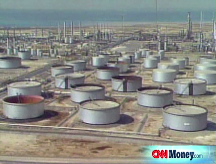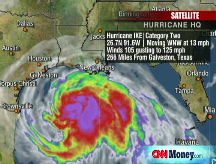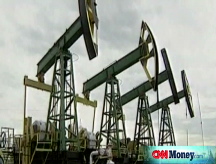Oil ends up after dip below $100
Crude futures settle higher as the market weighs the potential disruption of a hurricane heading toward Texas with slackening demand.

NEW YORK (CNNMoney.com) -- Oil prices zig-zagged Friday, briefly dipping below $100 a barrel for the first time in 5 months, as the the fury of a massive hurricane blowing toward refineries on the Texas coast countered .concerns about a global economic slowdown.
U.S. crude for October delivery briefly traded at $99.99 a barrel on the floor of the New York Mercantile Exchange, the first time oil has fallen below the $100 a barrel mark in more than five months.
The last time oil traded below $100 during a session was April 2, when it hit $99.84.
Oil recovered to settle up 31 cents at $101.18 a barrel. Earlier, prices rose as high as $102.89. Oil prices were volatile as traders gauged what Hurricane Ike's impact would be.
Ike: Hurricane Ike was 295 miles east of Corpus Christi, Texas, and 195 miles southeast of Galveston, Texas. The National Hurricane Center warned the public that "preparations to protect life and property in the hurricane warning area should be rushed to completion."
The Category 2 hurricane continues on its path across the Gulf Coast "but could reach the coast as a category three," according the National Hurricane Center.
"The reality is hitting the market in the face here," said Andrew Lebow, a broker at MF Global in New York. The storm veered toward the Houston refineries and by Friday, "the market is looking at how dangerous this storm really is," said Lebow.
"The market is really trying to determine how bad this storm is going to be," said Phil Flynn, senior market analyst at Alaron Trading.
Refineries in danger: Texas is home to 26 refineries, which can process almost 4.8 million barrels of crude per day, or more than 25% of the nation's total refining capacity, according to the Department of Energy. Most of Texas' refineries are the Gulf Coast ports of Houston, Port Arthur, and Corpus Christi. The entire Gulf Coast region houses 42% of total U.S. refinery capacity.
The refineries along the Texas Coast are more vulnerable to the strong winds and rain that Ike brings than the oil rigs in the Gulf. "It is not the oil rigs. They are pretty well reinforced," said Ray Carbone, president of Paramount Options, an oil trading company.
While Ike has not posed significant damage to crude rigs, if the refineries are shut down, the crude market will suffer repercussions eventually. Gas is a main product of crude oil. "If your end product is rallying, it has to have an effect on the raw material," said Lebow.
"It is going to be about flooding and power outages in the region," said Carbone. "Without power, no refineries will be working and the flooding could complicate how long it takes them to come back online."
Tom Kloza, chief oil analyst for Oil Price Information Service, an independent publisher that follows fuel prices in North America echoed those comments. After Katrina, some refineries were shut down for 6 to 9 months, said Kloza.
"Close to 20% of the U.S. refining capability could be lost for a long period of time," wrote Jim Rouiller, Senior Energy Meteorologist at Planalytics in an email. "Major and long term damage likely at the major refining cities from Galveston and Texas City northward to Baytown," he wrote.
"If the storm does damage to the refineries then we could see price increases in gas and heating oil," said Flynn. The decrease in supply of gas and heating oil due to Ike could be magnified by the fact that refineries had already been limiting their output because of slackening demand.
With Ike headed toward the Texas Gulf Coast refinery row, wholesale gas prices spiked Thursday and remained elevated Friday even as crude prices retreated. Late morning on Friday, wholesale gas prices were at $4.90 per gallon in the Gulf region, according to Kloza.
That price hike for dealers will push prices up at the pump, but not as drastically as wholesale gas prices have spiked. "No one wants to take the lead" in raising prices, said Kloza, so oil companies might try to cover as much of the price hike as they can for consumers.
Rigs shut: For the second time in two weeks, offshore platforms were being evacuated to avoid a major storm, according to the Minerals Management Service (MMS).
The government agency, which tracks offshore operations, estimated that 596 of the 717 manned production platforms - about 83.1% - remained evacuated in the wake of Hurricane Gustav earlier this month and in advance of Hurricane Ike.
As of Friday at noon ET, 96.9% of crude oil production and 93.3% of natural gas production in the Gulf of Mexico was shuttered, according to the Department of Energy.
The Department of Energy announced Thursday that it loaned 130,000 barrels of oil from the Strategic Petroleum Reserve (SPR) to Placid Oil's Port Allen refinery along a Shell pipeline in Louisiana and an additional 250,000 barrels of oil from the SPR to Marathon Petroleum Company's Midwest refineries along the Capline pipeline system. The companies had requested the oil due to disruptions from Hurricane Gustav.
The SPR is a 700-million barrel government-controlled reserve of crude oil.
The government released a preliminary Gustav damage report that said approximately 677 of 3,800 production platforms in the Gulf were exposed to hurricane conditions. One small platform off the coast of Louisiana was destroyed, according to MMS, and five platforms "received moderate damage," the statement said.
Demand, dollar: Even as Ike threatened the Gulf Coast region, oil prices remained near five-month lows, because the oil market has been fixated on the global economic slowdown chipping away at demand for pricey energy. Crude prices have fallen more than $46 from the record-high of $147.27 a barrel, set July 11.
People "were buying oil because they thought that the rest of the world would continue to demand oil," said Flynn. "Now, with the rest of the world's economy slowing down, we are seeing that global demand for energy is falling."
The International Energy Agency on Wednesday lowered its demand forecast for the next two years. IEA said world demand for oil will average 86.8 million barrels per day in 2008, 100,000 barrels per day lower than it had originally forecast. In 2009, demand will be 87.6 million barrels per day, 140,000 barrels per day lower than it had announced in its previous report.
"Oil should probably already be below $100," said Flynn. "The impact of Ike so far is basically stopping the free fall."
"If Ike does not do was much damage as people fear, I think we could see the sell off accelerate and we could get back to the $80s," said Flynn. "Ike can be a game changer for this market."
In addition, the stronger dollar has weakened oil prices. Crude oil is traded in U.S. currency around the globe, and so when the dollar strengthens, crude prices move lower.
Special trading session: With Ike heading toward the Gulf Coast, the Chicago Mercantile Exchange announced that it would hold a special, additional electronic trading session.
Globex trading for oil will begin on Sunday at 10 a.m. ET with a 9:30 a.m. pre-open. Typically, electronic trading on Sunday begins at 6 p.m. in time for early trading in Asia. ![]()






